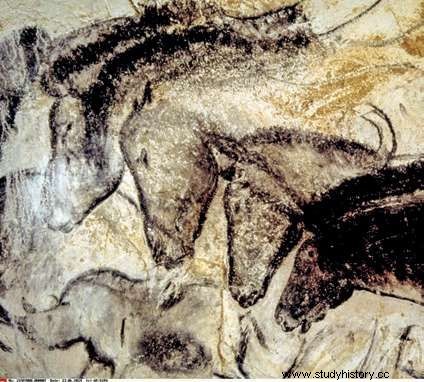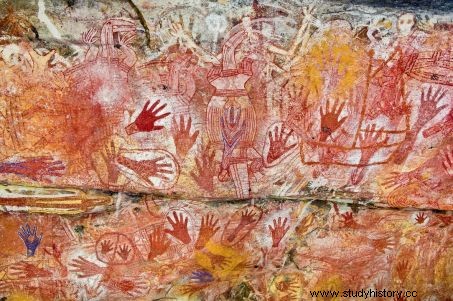For tens of thousands of years, prehistoric humans adorned the walls of caves and rock shelters. What meaning should be given to these creations that appeared in the Upper Palaeolithic? Some answers with the prehistorian Carole Fritz and the Australian archaeo-anthropologist Bruno David.

Bruno David is an archaeo-anthropologist at Monash University, Australia. Author of half a dozen books, he collaborates on various projects in Australia, Asia-Pacific and America. Carole Fritz is prehistorian, head of the Research and Study Center for Prehistoric Art (Creap Émile-Cartailhac, UMR 5608 TRACES (CNRS), in Toulouse scientific director of the Chauvet-Pont d'Arc cave (Ardèche). Above, our journalist Bernadette Arnaud.
This dialogue on parietal art is taken from Science and the Future - Research 887, dated January 887. It is enriched here with the video interview recorded on this occasion.
Sciences et Avenir:Why did Upper Paleolithic societies suddenly start decorating the walls of caves and rock shelters?
Carole Fritz:The phenomenon is multifactorial. I am a strong believer in the mythological interpretation of Upper Paleolithic drawings in Western Europe. We are a certain number to think that this need was born from a social and cognitive maturation of Homo sapiens around -38,000/-40,000 years ago. Humans felt the need to inscribe their mythology in images on the rock faces. And these myths organized the social fact.
Bruno David:These social representations, with their symbolism, are indeed always situated in cosmologies. Carole talks about myths, I talk about cosmology.
This dialogue on parietal art is taken from Sciences et Avenir - La Recherche 887, dated January 887. It is enriched here with the video interview recorded on this occasion.
Sciences et Avenir:Why did Upper Paleolithic societies suddenly start decorating the walls of caves and rock shelters?
Carole Fritz: The phenomenon is multifactorial. I am a strong believer in the mythological interpretation of Upper Paleolithic drawings in Western Europe. We are a certain number to think that this need was born of a social and cognitive maturation of Homo sapiens around -38,000/-40,000 years ago. Humans felt the need to inscribe their mythology in images on the rock faces. And these myths organized the social fact.
Bruno David: These social representations, with their symbolism, are indeed always situated in cosmologies. Carole talks about myths, I talk about cosmology.
Could Neanderthal have been the author of cave paintings?
Is parietal art unique to Homo sapiens or can it also be attributed to Neanderthals as some scholars suggest?
C. F.: Thanks to 3D medical imaging, we can now reconstruct the endocranium, that is to say the shape of the brain and the furrows it contains from a fossil skull. Sapiens and Neanderthals do not have the same shape of the cranium, which implies different morphologies of the brain. At sapiens , this allowed the development of certain brain areas related to self-perception, a more complex abstraction as well as a complexification of language in connection with mutations of the proteins of the FOXP2 gene which caused speech to emerge. However, graphic expression is intimately associated with language.
By combining the evolution of the brain, the problems of language mutation and the complexification of society, Homo sapiens is indeed the first draftsman of humanity. Which is not to say that Neanderthal had no myths or self-awareness, but his society and volume of abstraction were not complex enough for him to achieve, for example, works such as those of the Chauvet cave.
B. D.: Remember also that we have not yet found, for the time being, any rock art of which Neanderthal would be the author at -100,000, -80,000, or -70,000 years ago, apart from small pictorial examples which are debatable.
Unlike Europe, the Australian continent has an Aboriginal population that maintains a close connection with rock art. How do these companies view painted shelters?
B. D.: There are over 500 Aboriginal cultures in Australia. And to consider the different ways they interact with rock art sites, one must first understand what dreaming is. ["dream time"]. This is not a calendar but a cosmological perspective. For the Aborigines, the ancestors created the world and then passed on to the tribes their dances, their languages, their symbols, their representations… everything that makes up a culture. Each group having its own ancestors, this heritage is different from one to another. As these transmissions progress, the ancestors are metamorphosed in the earth, in the rocks... while still being alive.
Thus, the "dreamtime" brings together past and present:when an individual is born, the spirit of his ancestors accompanies him and it is identical to that found in paintings or in the earth of a site. Let's take the example of a kangaroo:it jumps, and by jumping it creates the hills. If this kangaroo is my ancestor - as is possible within Aboriginal societies - that means these hills are also my ancestors. Let us then admit that a hunter cuts the tail of the kangaroo:the spilled blood becomes a red ocher which is also my ancestor. If it happens that this kangaroo is painted on a rock, it will be himself who, during a dream, will have given the idea to the designer. The ancestors merge with the individuals. This is the principle of "dream time".
The parietal site would be the point of convergence of this principle?
Somehow. The landscape that surrounds me is the heir to all the events that have taken place there since the time of my ancestors. My spirit and that of my ancestors give it life. But the Dreamtime is also defined by what the Aborigines call the Law, again transmitted by the ancestors to behave in society. They also often use the phrase:“caring for country [taking care of the country]. Thus, when paintings begin to disappear from the rock, the Aborigines explain this erasure by the fact that we no longer pay attention to the country, therefore to the ancestors, and that the latter therefore no longer have any reason to stay. They are leaving…
"In Aboriginal societies, we know very well that women are also artists" - Bruno David
Do you think we can learn anything from this for Paleolithic art?
C. F.: I measure what we, anthropologists of the Upper Palaeolithic, have lost in terms of information in the West! If we had even a quarter of what has just been said about the Aborigines, we could propose scenarios of social organization, of links between individuals. There has been a permanence of people in Australia for 50,000 years and even if the Aborigines of today are different from the first arrivals, we know - thanks to anthropology - that the myths do not die, but are transformed. This continent is rich in a common fund that comes from very far away. It is a very interesting model to try to understand Paleolithic art in its duration.
Rock art is a universal phenomenon. However, since the 19th century, studies have concentrated a great deal on Western Europe. Isn't this a bias to analyze these prehistoric works?
B. D.: In Australia, we have been fortunate to benefit from Aboriginal cosmological ways of thinking. As a result, paradoxically, the symbolism of rock art was almost completely ignored by Australian archaeologists and anthropologists until the 1980s. prehistoric art:how to better understand the context of the occupation of the sites? How do people communicate from one place to another? Australian anthropologists do not ask themselves the question of its intrinsic significance, especially since the cosmology of a site varies from one tribe to another.
Thus, the peoples of Arnhem Land in northern Australia are divided into two groups. All light colors - white or yellow, for example - belong to the Yirritja, and dark colors to the Dhuwa. The same for long or short things. All symbolism is thus divided. Whoever paints a kangaroo - to take this example again - therefore does so with the symbolism that he has the right to use, drawing in a particular style known as X-rays. Whereas in the Kimberley, a few hundred kilometers away , the cosmology is totally different!
In Europe, animals are more present than humans in decorated cavities. How to explain it?
C. F.: I think there are two forms of art. That of hunters-gatherers-gatherers and that of agro-pastoralists. This has spawned different views of the world. In the Upper Palaeolithic, between -38,000 and -12,000 years ago, the use of the ubiquitous bestiary varied very little (bison, ibex, horse, mammoth, feline, bear, rein, megaloceros, etc.). Human representations do not exceed 5% of the corpus and it is mostly women's bodies or elements of these bodies that are represented. My interpretation of this is that in the Upper Palaeolithic, humans were just one animal among others. It is not the main predator having, above it, the large carnivores. And this link between these hunter-gatherers and their environment is very difficult for some in Europe to understand.
Were women, as much as men, able to make these paintings?
C. F.: A recent article published in the journal Sciences Advance s reports the discovery of the tomb of a young woman buried with hunting weapons in Peru, 9000 years ago. However, a number of anthropologists believe that women in the Palaeolithic could not hunt because of blood and the prohibitions associated with it in primitive societies, as is still sometimes the case today. But the way we look at these societies is changing and will continue to do so. Let's not forget that prehistory has long been studied by men, which greatly influences the interpretation of facts.
Without excessive feminism, let's just remember that these societies were made up of men, women and children! And that the shamans of Siberia are, even today, mainly women. So I don't see why the populations of the Upper Paleolithic would have deprived themselves of the talents of a woman if she painted very well!
B. D. :In Australia, this kind of question hasn't been asked for at least thirty years! In aboriginal societies, we know very well that women are also artists.
"In the Upper Palaeolithic, humans were only one animal among others, they were not the main predator" - Carole Fritz

The first cartoonist of humanity was Homo sapiens , thanks to the mutations of its brain and its social structures (Chauvet cave, Ardèche). (AP PHOTO/SIPA)

Australian Rock Paintings refer to a cosmology and therefore to a symbolism that differs according to the various aboriginal groups. (Here, rock paintings of Mount Borradail, Arnhem Land, Northern Territory.) (LEMAIRE STÉPHANE / HEMIS.FR)
Dialogue moderated by Bernadette Arnaud
